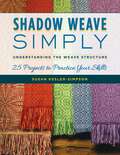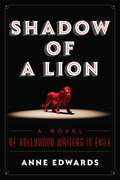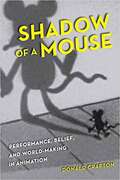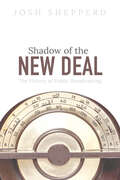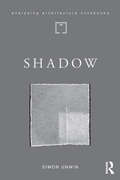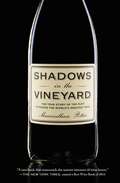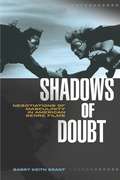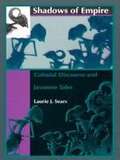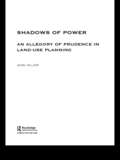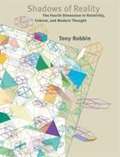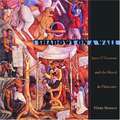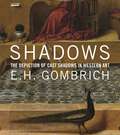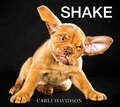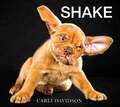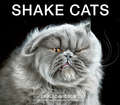- Table View
- List View
Shadow Weave Simply: Understanding the Weave Structure 25 Projects to Practice Your Skills
by Susan Kesler-SimpsonAdd Shadow Weave to your repertoire with Susan Kesler-Simpson's easy-to-follow instructions.Susan's approach is to first break down the structure of Shadow Weave so that any level weaver can understand how alternating light and dark threads in both warp and weft can present a dominant motif outlined with an identical shadow. She walks you through how the structure builds and weaves, and once you comprehend how the weave structure works, you will be able to weave any of the 25 project patterns in the book. You will also have the knowledge to transform other drafts to Shadow Weave, or to design your own Shadow Weave pattern.
Shadow of a Lion: A Novel of Hollywood Writers in Exile
by Anne EdwardsOn September 23, 1947, a number of the film industry&’s leading writers, producers, and directors received subpoenas that summoned them to Washington to testify before the Un-American Activities Committee of the House of Representatives. The McCarthy era had begun—and with it the destruction of hundreds of careers. This bold, multidimensional novel recreates life in the inner circles of the film industry in Washington, Hollywood, and the major capitals of Europe, portraying desparate people trying to rebuild their lives in the wake of McCarthyism.
Shadow of a Mouse: Performance, Belief, and World-making in Animation
by Donald CraftonAnimation variously entertains, enchants, and offends, yet there have been no convincing explanations of how these films do so. Shadow of a Mouse proposes performance as the common touchstone for understanding the principles underlying the construction, execution, and reception of cartoons. Donald Crafton’s interdisciplinary methods draw on film and theater studies, art history, aesthetics, cultural studies, and performance studies to outline a personal view of animated cinema that illuminates its systems of belief and world making. <p><p>He wryly asks: Are animated characters actors and stars, just like humans? Why do their performances seem live and present, despite our knowing that they are drawings? Why is animation obsessed with distressing the body? Why were California regional artists and Stanislavsky so influential on Disney? Why are the histories of animation and popular theater performance inseparable? How was pictorial space constructed to accommodate embodied acting? Do cartoon performances stimulate positive or negative behaviors in audiences? Why is there so much extreme eating? And why are seemingly insignificant shadows vitally important? <p><p>Ranging from classics like The Three Little Pigs to contemporary works by Švankmajer and Plympton, these essays will engage the reader’s imagination as much as the subject of animation performance itself.
Shadow of the New Deal: The Victory of Public Broadcasting (The History of Media and Communication)
by Josh ShepperdDespite uncertain beginnings, public broadcasting emerged as a noncommercial media industry that transformed American culture. Josh Shepperd looks at the people, institutions, and influences behind the media reform movement and clearinghouse the National Association of Educational Broadcasters (NAEB) in the drive to create what became the Public Broadcasting Service and National Public Radio. Founded in 1934, the NAEB began as a disorganized collection of undersupported university broadcasters. Shepperd traces the setbacks, small victories, and trial and error experiments that took place as thousands of advocates built a media coalition premised on the belief that technology could ease social inequality through equal access to education and information. The bottom-up, decentralized network they created implemented a different economy of scale and a vision of a mass media divorced from commercial concerns. At the same time, they transformed advice, criticism, and methods adopted from other sectors into an infrastructure that supported public broadcasting in the 1960s and beyond.
Shadow: the architectural power of withholding light (Analysing Architecture Notebooks)
by Simon UnwinEach of these Analysing Architecture Notebooks is devoted to a particular theme in understanding the rich and varied workings of architecture. They can be thought of as addenda to the foundation volume Analysing Architecture, which first appeared in 1997 and has subsequently been enlarged in three further editions. Examining these extra themes as a series of Notebooks, rather than as additional chapters in future editions, allows greater space for more detailed exploration of a wider variety of examples, whilst avoiding the risk of the original book becoming unwieldy. Shadows may be insubstantial but they are, nevertheless, an important element in architecture. In prehistoric times we sought shade as a refuge from the hot sun and chilling rain. Through history architects have used shadows to draw, to mould form, to paint pictures, to orchestrate atmosphere, to indicate the passing of time … as well as to identify place. Sometimes shadow can be the substance of architecture.
Shadows in the Vineyard: The True Story of the Plot to Poison the World's Greatest Wine
by Maximillian PotterWhen Maximilian Potter went to Burgundy to report for Vanity Fair on a crime that could have destroyed the Domaine de la Romanée Conti-the tiny, storied vineyard that produces the most expensive, exquisite wines in the world-he soon found a story that was much larger, and more thrilling, than he had originally imagined. In January 2010, Aubert de Villaine, the famed proprietor of the DRC, received an anonymous note threatening the destruction of his priceless vines by poison-a crime that in the world of high-end wine is akin to murder-unless he paid a one million euro ransom. Villaine believed it to be a sick joke, but that proved a fatal miscalculation; the crime was committed and shocked this fabled region of France. The sinister story that Potter uncovered would lead to a sting operation by top Paris detectives, the primary suspect's suicide, and a dramatic trial. This botanical crime threatened to destroy the fiercely traditional culture surrounding the world's greatest wine. Like Midnight in the Garden of Good and Evil, SHADOW IN THE VINEYARD takes us deep into a captivating world full of fascinating characters, small town French politics, an unforgettable narrative, and a local culture defined by the twinned veins of excess and vitality and the deep reverent attention to the land that run through it.
Shadows of Doubt: Negotiations of Masculinity in American Genre Films
by Barry Keith GrantIn Shadows of Doubt: Negotiations of Masculinity in American Genre Films, Barry Keith Grant questions the idea that Hollywood movies reflect moments of crisis in the dominant image of masculinity. Arguing instead that part of the mythic function of genre movies is to offer audiences an ongoing dialogue on issues of gender, Grant explores a wide range of genre films, including comedies, musicals, horror, science fiction, westerns, teen movies, and action films. In ten chapters arranged chronologically according to the films discussed, Grant provides a series of close analyses of such disparate films such as Broken Blossoms, The Fatal Glass of Beer, Red River, 2001: A Space Odyssey, Night of the Living Dead, and The Hurt Locker to demonstrate that representations of masculinity in the movies involve a continuous process of ideological testing and negotiation. While some of the films considered offer important challenges to dominant representations of masculinity, others reveal an acceptance or capitulation to them. Always attentive to the details of individual film texts, Grant also places the genre films he discusses within their historical contexts and the broader contexts and traditions of popular culture that inform them, including literature, theater, and music. Scholars of film and television studies as well as readers interested in gender studies will appreciate Shadows of Doubt.
Shadows of Empire: Colonial Discourse and Javanese Tales
by Laurie J. SearsShadows of Empire explores Javanese shadow theater as a staging area for negotiations between colonial power and indigenous traditions. Charting the shifting boundaries between myth and history in Javanese Mahabharata and Ramayana tales, Laurie J. Sears reveals what happens when these stories move from village performances and palace manuscripts into colonial texts and nationalist journals and, most recently, comic books and novels. Historical, anthropological, and literary in its method and insight, this work offers a dramatic reassessment of both Javanese literary/theatrical production and Dutch scholarship on Southeast Asia.Though Javanese shadow theater (wayang) has existed for hundreds of years, our knowledge of its history, performance practice, and role in Javanese society only begins with Dutch documentation and interpretation in the nineteenth century. Analyzing the Mahabharata and Ramayana tales in relation to court poetry, Islamic faith, Dutch scholarship, and nationalist journals, Sears shows how the shadow theater as we know it today must be understood as a hybrid of Javanese and Dutch ideas and interests, inseparable from a particular colonial moment. In doing so, she contributes to a re-envisioning of European histories that acknowledges the influence of Asian, African, and New World cultures on European thought--and to a rewriting of colonial and postcolonial Javanese histories that questions the boundaries and content of history and story, myth and allegory, colonialism and culture.Shadows of Empire will appeal not only to specialists in Javanese culture and historians of Indonesia, but also to a wide range of scholars in the areas of performance and literature, anthropology, Southeast Asian studies, and postcolonial studies.
Shadows of Power: An Allegory of Prudence in Land-Use Planning (RTPI Library Series)
by Jean HillierShadows of Power examines public policy and in particular, the communicative processes of policy and decision-making. It explore the important who, how and why issues of policy decisions. Who really takes the decisions? How are they arrived at and why were such processes used? What relations of power may be revealed between the various participants?Using stories from planning practices, this book shows that local planning decisions, particularly those which involve consideration of issues of 'public space' cannot be understood separately from the socially constructed, subjective territorial identities, meanings and values of the local people and the planners concerned. Nor can it be fully represented as a linear planning process concentrating on traditional planning policy-making and decision-making ideas of survey analysis-plan or officer recommendation-council decision-implementation. Such notions assume that policy-and decision-making proceed in a relatively technocratic and value neutral, unidirectional, step-wise process towards a finite end point. In this book Jean Hiller explores ways in which different values and mind-sets may affect planning outcomes and relate to systemic power structures. By unpacking these and bring them together as influences on participants' communication, she reveals influences at work in decision-making processes that were previously invisible.If planning theory is to be of real use to practitioners, it needs to address practice as it is actually encountered in the worlds of planning officers and elected representatives. Hillier shed light on the shadows so that practitioners may be better able to understand the circumstances in which they find themselves and act more effectively in what is in reality a messy, highly politicised decision-making process.
Shadows of Reality: The Fourth Dimension in Relativity, Cubism, and Modern Thought
by Tony RobbinIn this insightful book, which is a revisionist math history as well as a revisionist art history, Tony Robbin, well known for his innovative computer visualizations of hyperspace, investigates different models of the fourth dimension and how these are applied in art and physics. Robbin explores the distinction between the slicing, or Flatland, model and the projection, or shadow, model. He compares the history of these two models and their uses and misuses in popular discussions. Robbin breaks new ground with his original argument that Picasso used the projection model to invent cubism, and that Minkowski had four-dimensional projective geometry in mind when he structured special relativity. The discussion is brought to the present with an exposition of the projection model in the most creative ideas about space in contemporary mathematics such as twisters, quasicrystals, and quantum topology. Robbin clarifies these esoteric concepts with understandable drawings and diagrams. Robbin proposes that the powerful role of projective geometry in the development of current mathematical ideas has been long overlooked and that our attachment to the slicing model is essentially a conceptual block that hinders progress in understanding contemporary models of spacetime. He offers a fascinating review of how projective ideas are the source of some of today's most exciting developments in art, math, physics, and computer visualization.
Shadows on a Wall: Juan O'Gorman and the Mural in Pátzcuaro
by Hilary MastersNovelist and essayist Hilary Masters recreates a moment in 1940s Pittsburgh when circumstances, ideology, and a passion for the arts collided to produce a masterpiece in another part of the world.
Shadows: The Depiction of Cast Shadows in Western Art
by E. H. Gombrich Neil Macgregor Nicholas PennyIn this intriguing book, E. H. Gombrich, who was one of the world’s foremost art historians, traces how cast shadows have been depicted in Western art through the centuries. Gombrich discusses the way shadows were represented--or ignored--by artists from the Renaissance to the 17th century and then describes how Romantic, Impressionist, and Surrealist artists exploited the device of the cast shadow to enhance the illusion of realism or drama in their representations. First published to accompany an exhibition at the National Gallery, London, in 1995, it is reissued here with additional color illustrations and a new introduction by esteemed scholar Nicholas Penny. It is also now available as an enhanced eBook, with zoomable images and accompanying film footage.
Shake
by Carli DavidsonOriginal, amusing, and brilliantly documented, Shake is a heartwarming collection of sixty-one beguiling dogs caught in the most candid of moments: mid-shake. This glorious, graphic volume will stop you dead in your tracks as you are presented with images of mans best friend caught in contortion: hair wild, eyes darting, ears and jowls flopping every which way. With Shake, photographer Carli Davidson proves how eager and elated we are to see our pets in new ways. The result is a one-of-a-kind book: a colorful assemblage of photographs that are simultaneously startling and endearing, consistently hard to look away from, and revealing.
Shake
by Carli DavidsonOriginal, amusing, and brilliantly documented, Shake is a heartwarming collection of sixty-one beguiling dogs caught in the most candid of moments: mid-shake. This glorious, graphic volume will stop you dead in your tracks as you are presented with images of man's best friend caught in contortion: hair wild, eyes darting, ears and jowls flopping every which way.With Shake, photographer Carli Davidson proves how eager and elated we are to see our pets in new ways. The result is a one-of-a-kind book: a colorful assemblage of photographs that are simultaneously startling and endearing, consistently hard to look away from, and revealing.
Shake Cats
by Carli DavidsonThe fur flies in this irresistible third installment in the bestselling Shake series by popular pet photographer Carli Davidson, featuring adorable and hysterical color photographs of more than sixty cats caught mid-shake. <P><P> Pet photographer Carli Davidson has enchanted readers around the world with her adorable photographs of man’s best friend in Shake and Shake Puppies. Now, she turns her lens on felines in this sweet and heartwarming volume that is pure catnip for cat lovers. <P> Shake Cats includes more than 130 gorgeous, highly detailed color pictures of felines in mid-shake. Like its predecessors Shake and Shake Puppies, it showcases a charming double-page layout—each spread features two images of the same cat placed side by side to capture the unique movement of the shake. <P> Inside, fans will find a roster listing the names, ages, and breeds of cats photographed. Davidson also provides outtake images of her shoots with the cats, a short, insightful description that explains her process, and information about animal rescue to encourage people considering a new cat to choose a rescue animal. <P> A truly incomparable book—as beautifully designed as it is humorous—Shake Cats is the ultimate gift for every cat lover.
Shake, Rattle and Roll: Rhythm Instruments and More for Active Learning
by Abigail Flesch ConnorsMusic and movement go together like books and reading--they spread joy! It's no secret that quiet doesn't always equal quality learning. At times, we struggle to help children settle down so they can listen and learn. However, we can also encourage them to move to the beat so they can listen and learn in more active ways. In Shake, Rattle, and Roll: Rhythm Instruments and More for Active Learning, you will find activities that inspire curiosity, exploration, and creativity. When children are singing, moving, listening, and playing music, their creative energy enhances their learning in many areas like Language Arts and Math. Because there is not just one right way to play rhythm instruments or move to the beat, children can explore their own capabilities while they dance, sing, and play.
Shake, Wiggle & Roll
by Carli DavidsonIn Shake, Wiggle & Roll, babies and toddlers will be moving and grooving with playful pups as they show off favorite doggie moves, from chomping and chewing to jumping and leaping. With lively images from the lens of expert animal photographer Carli Davidson, this sturdy book is perfect for the very youngest readers—and fun for the whole family.
Shake, Wiggle & Roll
by Carli DavidsonFrom an award-winning animal photographer, these hilarious action photos of lovable dogs &“will delight kids and caregivers alike&” (Kirkus Reviews, starred review). With Shake, Wiggle & Roll, babies and toddlers will be moving and grooving with playful pups as they show off favorite doggie moves, from chomping and chewing to jumping and leaping. Filled with lively images from the lens of expert animal photographer Carli Davidson and accompanied by simple words from &“walk&” to &“wag,&” this book is perfect for the very youngest readers—and fun for the whole family. Praise for the writing of Carli Davidson &“Playful typographic details add to the fun . . . Davidson&’s photographic portraits . . . are revelatory in the detail they capture, and exude compassion and respect for each subject.&” —Publishers Weekly (starred review) &“A heartwarming collection.&” —The Telegraph &“Holy cow, this is adorable!&” —Good Housekeeping
Shaken, Not Stirred!: James Bond in the Spotlight of Physics (Science and Fiction)
by Joachim Stolze Metin TolanHow do James Bond’s X-ray glasses work, the ones he uses to see whether the lady at the roulette table has a pistol concealed in her underwear? Is it really possible to launch oneself into the air and catch up with a plane that is free-falling towards the earth? Or to shoot down a helicopter with a pistol? In this lively and informative book, Germany's boldest physics professor Metin Tolan analyses the stunts and gadgets of the 007 films and even answers the question of all questions: Why does Bond drink his vodka martini shaken, not stirred? "So much entertaining science is a rare thing." Spiegel Online
Shaker Fancy Goods
by Catherine S. GoldringShaker Fancy Goods tells the story of the Shaker Sisters of the nineteenth and early twentieth century who responded to the economic perils of the Industrial Revolution by inventing a lucrative industry of their own—Fancy Goods, a Victorian term for small adorned household objects made by women for women. Thanks to their work ethic, business savvy, and creativity, the tireless Shaker Sisters turned a seemingly modest trade into the economic engine that sustained their communal way of life, just as the men were abandoning the sect for worldly employment. Relying on journals and church family records that give voice to the plainspoken accounts of the sisters themselves, the book traces the work they did to establish their principal revenue streams, from designing the products, to producing them by hand (and later by machine, when they could do so without compromising quality) to bringing their handcrafts to market. Photographs, painstakingly gathered over years of research from museums and private collections, present the best examples of these fancy goods. Fancy goods include the most modest and domestic of items, like the pen wipes that the Sisters shaped into objects such as dolls, mittens, and flowers; or the emeries, pincushions, and needle books lovingly made back in an era when more than a minimal competency in sewing was expected in women; to more substantial purchases like the Dorothy cloaks that were in demand among fashionable women of the world; or the heavy rib-knitted sweaters, cardigans, and pullovers that became popular items among college boys and adventurous women.
Shaker Furniture
by Edward D. Andrews48 sharp photos show side chairs, long benches, rocking chairs, chests, cupboards, much more. Exact measurements given for each piece to aid in identification, reconstruction, restoration. Also--highly readable commentary on sect's cultural background.
Shaker Heights (Images of America)
by Bruce T. MarshallShaker Heights achieved international renown in the early 20th century as an enclave for wealthy residents--a city of stunning homes, substantial green space, an excellent school system, and attentive municipal services. Cleveland entrepreneurs O. P. and M. J. Van Sweringen established Shaker Heights as a haven from the stresses of city life and claimed a connection with previous residents of this land, the North Union settlement of Shakers. Shaker communities sought to create paradise on earth by living communally and focusing on the life of the spirit. Buyers in Shaker Heights were assured that their paradise would last forever because of restrictions on what could be built and who could live there. Nevertheless, Shaker Heights has changed from a protected environment for the wealthy to a stable, integrated city that intentionally promotes diversity in its population. This is a remarkable story of dramatic change but also continuity as residents pursue the goal of creating an ideal community.
Shakescenes: Shakespeare for Two
by William Shakespeare John Brown35 scenes from Shakespeare are presented in newly-edited texts, with notes which clarify meanings, topical references, puns, ambiguities, etc. A brief description of characters and situation prefaces each scene, and is followed by a commentary which discusses its major acting challenges and opportunities. Each scene has been chosen for its independent life requiring only the simplest of stage properties and the barest of spaces.
Shakespeare & Company: When Action is Eloquence
by Tina Packer Bella MerlinShakespeare & Company: When Action is Eloquence is the first comprehensive insight into this internationally acclaimed company founded in 1978 in Lenox, Massachusetts, by actor-director Tina Packer and voice pioneer Kristin Linklater, with the transformative power of Shakespeare’s language at its heart. Why act Shakespeare? What’s his relevance in the twenty-first century? Compelling answers to these questions lie at the center of this highly accessible journey into Shakespeare & Company’s aesthetics and practice. Drawing on hitherto unpublished material – including notebooks, lectures, interviews, rehearsal diaries – and the Company’s newly collated archive, this book provides insight into a working theatre company and sheds light on the role Shakespeare plays in our modern world. It also details: Shakespeare & Company’s founding and early history Its aesthetic based on the Elizabethan theatre’s principles of the Art of Rhetoric; Structure of the Verse; Voice and Movement; Clown; Fight; and Actor/Audience Relationship Vocational components of its Training Intensives Practical pedagogy of its Education programs Insights into its unique approaches to Performance Impact and legacy of its three lifetime founding members: Dennis Krausnick (Director of Training), Kevin G. Coleman (Director of Education) and Tina Packer (founding artistic director). Actors, directors, students, educators, scholars and theatre-lovers alike will find practical acting strategies, inspirational approaches to theatre making and lively insights into the sustaining of a unique and robust theatre company that has been thriving for over 40 years.
Shakespeare Beyond English
by Susan Bennett Christie CarsonTackling vital issues of politics, identity and experience in performance, this book asks what Shakespeare's plays mean when extended beyond the English language. From April to June 2012 the Globe to Globe Festival offered the unprecedented opportunity to see all of Shakespeare's plays performed in many different world languages. Thirty-eight productions from around the globe were presented in six weeks as part of the World Shakespeare Festival, which formed a cornerstone of the Cultural Olympics. This book provides the only complete critical record of that event, drawing together an internationally renowned group of scholars of Shakespeare and world theatre with a selection of the UK's most celebrated Shakespearean actors. Featuring a foreword by Artistic Director Dominic Dromgoole and an interview with the Festival Director Tom Bird, this volume highlights the energy and dedication that was necessary to mount this extraordinary cultural experiment.
